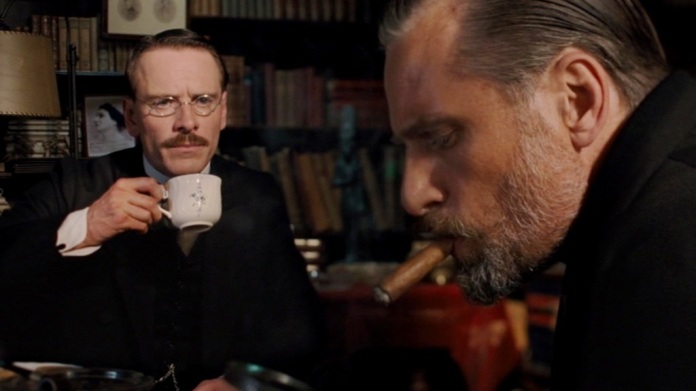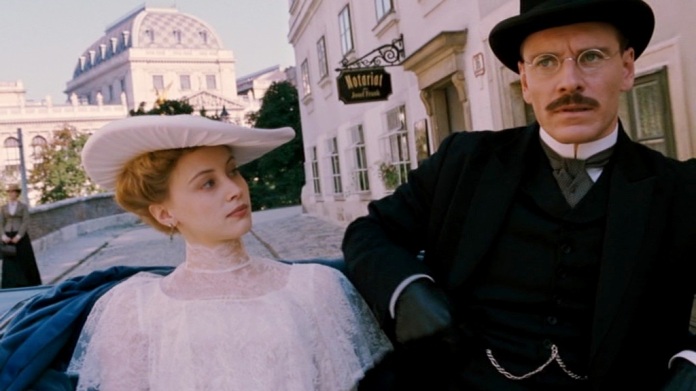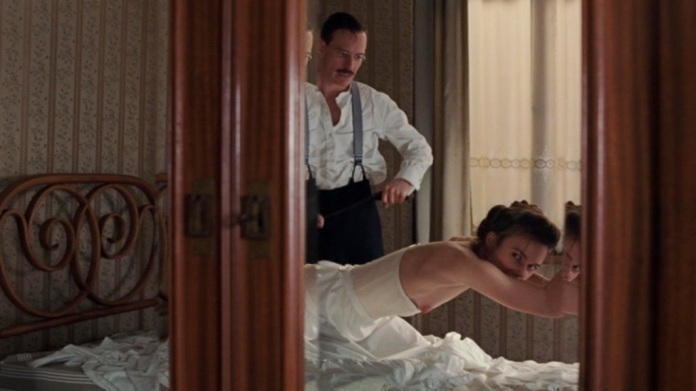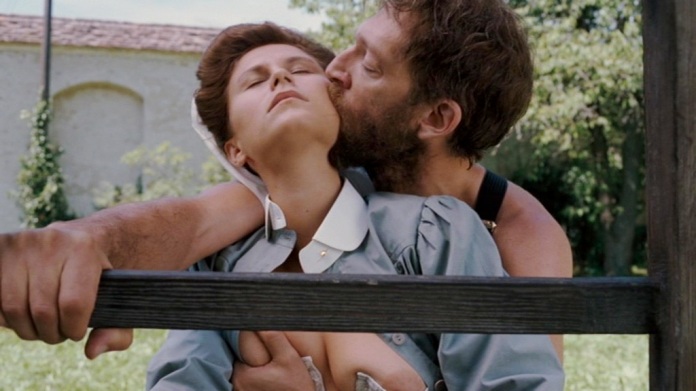.

Director: David Cronenberg
By Roderick Heath
I tend to blow hot and cold on David Cronenberg’s oeuvre, filled as it is with works such as Videodrome (1982), Naked Lunch (1991), and A History of Violence (2004) that strike me more as catalogues of interesting moments and ideas rather than completely coherent films. But it’s impossible to deny that the Canadian auteur has been one of modern mainstream cinema’s most consistently visceral, intelligent, and original fountainheads, and at his best, can be a fearsome artist of psychological straits and the overflowing id. Cronenberg’s reputation is still often immediately associated with his early, overtly horrifying essays in body distortion and corruption; thus, A Dangerous Method, his latest and one of his most subtle films, seems, in abstract, like an outlier. But A Dangerous Method’s guardedly realistic approach to character and historical setting revolves around some very Cronenbergian motifs, not the least of which is the strange and often perverse manner the inner self and the outer self relate.

The film’s early scenes are fixated on Keira Knightley’s unhinged performance as Sabina Spielrein, a young Russian Jewish woman who suffers from an overwhelming, physically manifest neurosis. Sabina, dragged out of the carriage that brings her to the Burghölzli Clinic in Switzerland in 1904, is placed into the care of Carl Jung (Michael Fassbender), a young, brilliant doctor at the clinic. He decides to employ Dr. Sigmund Freud’s theoretical and almost untested “talking cure” on her. Sabina, in the extremes of her disease, contorts and buckles and twists, her jaw elongating as things push about inside her, looking as if she’s about to explode like a character out of Scanners (1980) or undergo a transformation similar to Jeff Goldblum’s in The Fly (1986).

Sabina’s pathological pain and rage prove to have two sources: her hatred for her father, the kind of authoritarian who’d make her and her siblings kiss his hand after he struck them, and her powerful masochistic urges, partly imbued by that cruelty, that she can’t assimilate in any form other than as a kind demonic aberration. As Jung works with her, she slowly begins to return to a functioning state, and as part of her therapy, is encouraged to pursue her interest in studying medicine. Two male figures overtly and covertly influence her fate: Jung and his medical field’s unchallenged leader and guru, Freud (Viggo Mortensen). Not long after Sabina becomes Jung’s patient, the peculiarities of her case and Jung’s success in putting Freud’s method into practice becomes a catalyst for the two men to meet, form an initially powerful accord, and then slowly but surely break apart.

Freud, proud and fully aware of his virtually imperial position in a nascent realm of medicine, is actively searching for heirs apparent, and he soon declares Jung one. He entrusts to Jung’s care another of his potential heirs, Otto Gross (Vincent Cassell), a cocaine-sniffing libertine who begins to preach total liberation from traditional familial and social forms, and who is considered insane by his own authoritarian father. His egocentric arguments coincide with a time in Jung’s life when his rich wife Emma (Sarah Gadon) is pregnant, and their marriage is strained, leading Jung to capitulate to his attraction to Sabina.

We live in a world where the catchphrases and oversimplified versions of psychoanalytic theory have gone through phases of utter disdain, near-religious acceptance, and back again. A Dangerous Method sets out to portray a window in not-so-distant history when ideas of the self and society seemed set for a radical change, and the consequences of that change were still potentially inexhaustible, but the people offering the change were still irrevocably tethered to the world as it was. Freud and Jung are portrayed as men caged by their worldly concerns. It’s not the first film to look at the formative years of psychiatry and its figures: John Huston’s amazingly undervalued Freud (1962) pitched the tale of Freud’s speculative development as an expressionist detective story where the younger hero fights through his own neuroses to uncover experiences and epiphanies that he converts into his classic theories. Cronenberg’s film takes a calmer tack and comments wryly on the way Freud, Jung, and Spielrein each in their way turn a fierce personal intelligence in on itself with analytical daring, and yet still constantly give in to bad judgment and behaviours they would reject and criticise in others. Freud proves a fascinating mixture of wisdom, moral rectitude, and a powerful circumspection, even timidity, in the face of disrupting social assumptions and straying beyond immediate scientific rationales.

Many directors become long-winded, not always unfruitfully, but often indulgently, in their late-period films, but Cronenberg here has honed his style to a succinct, discretely impressive economy. He wastes no more frames and words than necessary in a series of interpersonal exchanges, like the way he shoots Jung’s sessions with Sabina constantly from in front her, her alarming visage dominating the foreground whilst the calmly listening doctor hovers behind. The stage origin of Hampton’s work is detectable in the essentially limited range of characters—only five of the actors really matter—and the largely conversational drive of the tale. Cronenberg’s approach to such material is cunning, breaking his film up in a fashion that makes us aware of leaps of time whilst maintaining unity in the flow of vignettes and talk reminiscent of epistolary novels, accumulating over a nine-year period and coalescing into a narrative. Cronenberg does this through a purposeful use of cuts between episodes that lack the usual passage-of-time film grammar, watching relationships evolve and devolve. Simultaneously, Christopher Hampton’s screenplay, adapted from his own play and a book by John Kerr, accumulates detail in an unforced but clear-minded and literate fashion: for Hampton, the story has clear affinities with his script for Agnieszka Holland’s Total Eclipse (1995), which similarly delved into the sordid affairs of fin de siècle antiheroes.

If A History of Violence and Eastern Promises (2007) saw Cronenberg leveraging flashes of personal inspiration out of essentially impersonal material, A Dangerous Method sees him thoroughly submerged in his chosen story, which has echoes as far back in his oeuvre as The Brood (1979). Rather than placing into a dramatic context the imagery of the id, here he peers with quiet wit at the forceful, often violent meeting of minds and bodies that gave life to modern psychological theory. Cronenberg, at any rate, steadfastly refuses to go in to standard biopic histrionics and structures the film backwards, with Sabina’s neurotic explosions all at the start; the finale sees the protagonists all diverging on solitary adventures. The mesh of cultural, political, and personal values that bind and define the characters is laid out in concise terms, especially when Freud draws Jung’s attention to the difficulties of their profession and that fact his theories are gaining credibility as being bound up in the overwhelming Jewish membership of the Viennese psychiatric circle. When Jung asks, “What’s that got to do with anything?” Freud replies, “That, if I may say so, is an exquisitely Protestant remark.” Freud is well aware that such irrational, yet potent prejudices as anti-Semitism can only give fuel to the aggression of his detractors, who will not stomach the implicit condemnation of all Victorian ideals of child-raising, and aspects of the social structure itself, that will inevitably flow out of psychotherapy’s new wisdom.

This is, after all, early 20th century Europe, with its uneasy blend of the liberal and untold lodes of hypocrisy and buried frustration that will soon be released in its orgiastic moment. Sabina seems a by-product of the peculiarly bestial undercurrents and power-favouring assumptions of the era, which the starched collars and trim skirts cocoon. Jung and Freud present less frenetic yet identifiable versions of the same thing, particularly well invested in Fassbender’s expert acting, as he squirms both within the assurances of his professional and actual garb and the tools of his mind to control his impulses, and yet he requires only slight encouragement to give into them. Nonetheless, in the first half of A Dangerous Method, Jung’s use of Freud’s talking cure pulls Sabina back from the brink of self-destruction and helps form a partnership between the two doctors, and the scene fulminates with creative and intellectual potential, as their first meeting goes on for hours before Freud first notices. Taking lunch in Freud’s apartment, Jung yammers away on sexual theory until Freud casually encourages him to not observe any conversational niceties, causing Jung to remember that Freud’s family are listening with beguiled fascination.

Cassell’s Gross is the serpent in this particular Eden, in which Freud is initially high priest and lawgiver who puts Jung and Gross together like the experimenter he is, hoping for another catalytic reaction, and then getting chagrined at some of the results. Gross proffers a blend of entitled addict’s reasoning and unapologetically rebellious attitude, which persuasively preaches a total freedom whilst seeming at the same time to be deeply disturbed. He penetrates Jung’s head with temptation exactly when he’s vulnerable to it, attracted to Sabina on several levels and alienated from his wife and her bourgeois rituals of family-rearing—rituals Gross mocks mercilessly. Perhaps the most revealing, biting, and propulsive aspect of A Dangerous Method is the way it identifies the porous boundaries of the psychoanalytical field, with characters stepping over borderlines between doctor and patient according to the necessity of the moment, and the implicit theory that it takes a neurotic to know a neurotic. “You’re exactly the sort of person we need,” Jung tells Sabina when she asks him if he thinks she can ever be a psychiatrist: “Insane, you mean?” she deadpans.

Jung’s actual affair with Sabina is undoubtedly sexual—Cronenberg casually zeroes in on the stain of blood left when he takes her virginity—but is punctuated by his indulging her masochistic desires. He’s glimpsed methodically smacking her backside as she writhes in erotic frenzy with the air of man simply extending therapy into the bedroom. Sabina sets out to seduce Jung out of romantic interest, but also to satisfy her growing awareness that a good psychoanalyst with an interest in sex like her ought to know something of what she’s talking about. Gross is glimpsed fornicating in the garden with a clinic nurse whose bored expression suggests it’s an equivalent to emptying bedpans and giving out medication, and Gross with an expression redolent of the junkie getting his daily fix. Gross commences as at least a tacitly functioning intellectual but soon enough flees like a man chased by ghosts, asking Jung to tell his father he’s dead. Sabina, on the other hand, travels from barely functioning wretch to a professional. Jung, after deciding early on to steer Sabina toward the medical ambitions she’s already harboured, makes her an assistant in experiments, including one in which he has his wife perform a word association test where the quiet discord in the Jungs’ marriage is made apparent to Sabina.

Jung’s privileged position is underlined when his wife buys him a huge house and a yacht whilst acquiescing coolly to the possibility of his having an affair, and just as coolly reclaiming him with the certainty that for all his percolating temptations to break with his fastidiously bourgeois upbringing and outlook, he’s effectively held within those limits by his own conscientious thinking. These factors do lead him to break with Sabina and even to try to obfuscate the nature of their relationship in his dealings with Freud, obfuscation Freud later claims as one reason for his severing his ties with Jung. But that split already began when Freud tried to block Jung’s desire to move beyond strict adherence to Freud’s purely sexual model, itself challenging enough that Freud predicts that people will still be resisting aspects of it for a century, and starts adopting theories the older man dismisses as unscientific nonsense. In one scene, Jung, having absorbed a criticism from the older man, suddenly begins interpreting a clicking sound emerging from a heating system that coincides with a twinging in his stomach as proof of the possibility of psychic anticipation. Of course, all what’s really manifesting is his anguish at Freud’s determination to remain the guardian at the bridge of legitimacy.

As with the word association scene, close to the film’s end, there’s a clever use of theory to introduce a new idea: in 1913, Jung recounts a dream we know contains a dread portent for the world he lives in, filled with images of waves of blood and piled corpses. Freud’s own spurts of unease when confronted by Jung’s wealth is drolly handled and gives a telling weight to Freud’s discomfort and determination to retain his intellectual leadership. Freud’s understanding of the perilous position he’s in, reminding Sabina of their shared Jewish responsibility, gains a chilling clarity in the coda where we’re reminded that Freud died as a refugee from the Nazis and that Sabina perished at the hands of an SS murder squad in 1942.

One quality of A Dangerous Method that distinguishes it from Cronenberg’s earlier films in a similar key—my favourite of his works, Dead Ringers (1988), and my least favourite, Crash (1996)—is that where he might have adopted an air of chilly archness when dealing with such characters and situations, the tone of this film also has a strong grasp on the hothouse feeling underneath. As with his uneven yet occasionally remarkable Eastern Promises, there’s a deep ocean of feeling and a quiet beauty to the film, as if Cronenberg has grasped at last a way to articulate passion as well as pathology without stooping to bathos. Fassbender’s characterisation of Jung is very much the centrepiece of the film, though he doesn’t dominate. Of the startling amount of work he’s ploughed through in the past 18 months, Fassbender gives one of his very best and most subtle performances here, capturing the finite play of guilt, frustration, attraction, and professional zeal in Jung, a man who doesn’t quite seem to find his sense of mission until after his break with Freud and his last goodbye to Sabina.

Undoubtedly when the time comes to estimate awards, the early scenes of the deeply disturbed Sabina will count most both for and against Knightley’s performance; but the quality of her acting is best noted by how she modulates the characterisation in the later stages, her overt symptoms dissipating, yet maintaining something freakishly odd about Sabina, who operates on a level of feverish strength beyond anything Jung and Freud can contemplate releasing in themselves. That strange intensity is most apparent in such moments as when she’s taking notes on a roomful of Jung’s patients listening to Wagner, hovering with a blend of geeky enthusiasm and hawkish intent. Mortensen is however perhaps the film’s quietest coup, incarnating his Freud as an icon of pipe-smoking sang froid and cagey authority. It’s as restrained a piece of star acting as you’ll ever see, and one of the most effective. Like the film itself, he’s so measured, smart, and effective, you almost don’t realise it.

Roderick,
Cronenberg has also been rather disappointing to me throughout his career. I, like you, have seen mostly inspired individual ideas, but a lack of sustained brilliance. I’m curious about this one and your great essay has leant me some additional inspiration to see it, as with it perhaps being somewhat different from his typical, but still containing some of his usual elements. Hope it’s great.
LikeLike
I would add as a corollary to my Cronenberg skepticism that it’s high time I revisited his work, as I haven’t seen a lot of it since I was a teenager. I didn’t like Eastern Promises when I first watched it, but in thinking back upon it realised how deep under the skin it got. In any event, I recommend this wholeheartedly, Jon, with thinking caps on.
LikeLike
“But A Dangerous Method’s guardedly realistic approach to character and historical setting revolves around some very Cronenbergian motifs, not the least of which is the strange and often perverse manner the inner self and the outer self relate. ”
Indeed, Beautifully posed and written. And happy days are here again as far as agreement on film goes. After fully concurring with your relative disdain for the overrated TAILOR TINKER TAILOR SPY (reviewed at “This Island Rod”) I come here to FERDY-ON-FILMS to find more agreement, and in spades. My favorite Cronenberg film is DEAD RINGERS, and my least favorite is CRASH, and for a bevy of reasons I found A DANGEROUS METHOD an accomplished period piece and a distinguished psychological study. You’ve framed all the intricacies of that latter point here most impressively, and I’ll just add that I agree fully that the performances of Keira Knightly, Michael Fassbender and Viggo Morteson, were all outstanding.
Fessbender has had quite a year what with JANE EYRE and SHAME to go with this, though I know most feel the former performance is the weak link. But you are quite right I think, when you suggest that the early scenes for Knightley will count both ‘for’ and ‘against’ her as far as the entire role is concerned. Anyway, love the specific reasons you give for why Fassbender was so effective here. Bravo.
A DANGEROUS METHOD is definitely a strong possibility for the year-end list as far as I’m concerned. Apparently you appear to evince the same conviction here.
LikeLike
I’m totally heartened to know you dug this and felt as I did about TTSS, Sam. Surprisingly enough, considering what is usually my year-end march of disappointment in catching up with the prestige fare, both this and Hugo, two big gaps (along with a couple still outstanding, including The Artist and The War Horse, which seems to have paid a price for being held back too long in the yearly stakes), proved to mostly live up to my high expectations, making up for the pain of TTSS and a few others. Indeed Fassbender’s had a dizzying year (and I’d add my admiration for his channeling of ’60s lethal cool in X-Men: First Class too), owing no apology for his fresh and non-clichéd take on Rochester. Yes, this will be on my best-of list. This has been an excellent year of cinema if one looked in the right places, and my list will reflect that, I hope.
LikeLike
This by far the best review of the film I have read. Thank you for writing something intellectually sharp and stimulating. You capture the heart of this film in all its nuance.
LikeLike
Much appreciated, Remy.
LikeLike